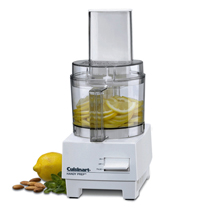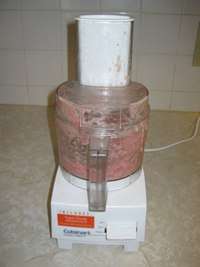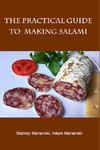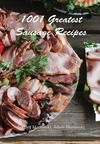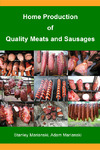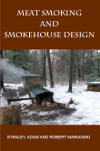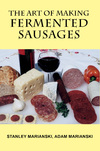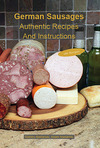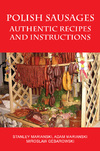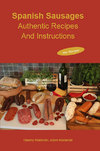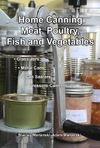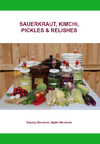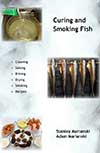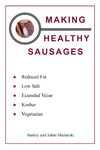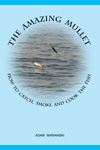Meats and Sausages
Cooked-Emulsified Sausages
,Emulsified sausages are cooked sausages that have been finely comminuted to the consistency of a fine paste. Hot dog, frankfurter, mortadella, bologna, liver sausage, pâté are typical examples. They are usually smoked and cooked with moist heat (steamed or in hot water). The first emulsified sausage was probably the German frankfurter, followed by the Austrian wiener. In the 1800s, German immigrants brought these recipes to America, and originally, these sausages were served like any other. The story goes that in 1904, a street vendor in St.Louis sold his wieners on small buns. They were nicknamed the “red hots” as they were too hot to handle with fingers. One day, he got this great idea of making a bun that would fit the shape of the sausage, and an American favorite “hot dog” was born.
Emulsified sausages can be divided into two groups:
- High-quality products made at home, such as Austrian wiener or Polish Serdelki, are made from high-quality meats without chemicals. Beef, veal and pork are the meats commonly used. Beef frankfurter contains beef only. High-quality products contain enough lean meat to absorb the necessary water without help from water retention agents.
- Commercial products made from all types of meat trimmings (pork, beef, chicken, turkey), including machine-separated meat. Chicken, turkey, and other combinations can be found in a supermarket. A large number of chemicals and water are added during manufacturing to compensate for lower meat grades.
The public prefers moist emulsified-sausages. It is hard to imagine a hot dog or frankfurter that will feel dry. In commercial production, meat is chopped in bowl cutters by rapidly moving blades, creating friction. This action develops heat, which encourages the growth of bacteria. To prevent that, The manufacturer adds crushed ice into the chopper to prevent that.
Emulsification will be successful if the following criteria are met:
- Enough lean meat has been selected. The lean meat is the main source of myosin protein. The more myosin extracted, the thicker and stronger the protein coat around particles of fat.
- Enough myosin has been extracted. This depends on how vigorous the cutting process was and how much salt was added.
Too much fat, especially when finely comminuted, creates such a large surface area that there may not be enough protein solution to coat fat particles. As a result, pockets of fat will form inside of the sausage. Some moisture is lost during smoking, cooking, and storage, so this factor must be accounted for. More water is added during chopping/emulsifying to compensate for those losses. Experienced sausage makers know that different meats possess different water-holding abilities. Lean meat can hold more water than fatty tissue. Organ meats such as heart, glands, pork and beef tripe, pork skin, or snout have poor water-holding capabilities. Red meat found in pork heads exhibits good water-holding capability. Generally, lean red meat holds water well, although beef is the best.
- Beef - high
- Veal - medium
- Pork - medium
Beef meat can absorb significant amounts of water:
- Bull meat - up to 100%
- Shank meat - up to 70%
- Cow meat - up to 60%
- Cheek meat - up to 40% ,
In simple terms, 100 lbs. of cow meat can absorb 60 lbs. of water and 100 lbs. of bull meat can absorb 100 lbs. of water. An average beef piece bought in a local supermarket should hold about 30-40% of added water. To make top quality emulsified sausages some lean red muscle meats should be used. This does not mean that the only best lean cuts of meat must be employed. Using meat trimmings, is in fact, encouraged. A typical frankfurter recipe consists of about 60% beef and 40% pork trimmings. Those trimmings may consist of cheaper grades of meat such as heart, cheek meat, pork or beef tripe, and fats. As long as lean beef is used to bind water, other “filler” meats may be added.
A commercial manufacturer can not afford the luxury of using only top quality meats. To keep the costs down, he has to use second-grade meat trimmings. There is nothing wrong with such meats from a nutritional point of view, however, adding water holding substances will help to absorb and hold water within the meat structure. If you study recipes for making emulsified sausages from earlier times when chemicals were not yet widely used, you will see that beef was always ground with a smaller plate than pork. This was done to fully extract meat proteins allowing meat to absorb more water.
The fats don't hold water, so fat is added to the bowl cutter at the end. If show meats (larger pieces) or chunks of fat (Mortadella) are required, they will be mixed with emulsified meat at the end.
Water
Water plays an important part:
- It helps to extract water soluble proteins (actin and myosin) which contribute to better meat binding and strong emulsion.
- Cold water and crushed ice help to keep the temperature down during emulsification.
Manufacturing Process
Meat selection
- Lean beef, veal, lean pork. Keep in mind that the color of the sausage will depend on the type of meat used (myoglobin content) and, to a smaller degree, on spices.
- Fat
About 20% of fat is needed for good texture, taste and flavor. Hard and soft fats can be used. Pork fat, beef fat, mutton fat, chicken fat or even vegetable oils can be utilized. Beef and lamb fat have a very strong flavor which can be masked by a careful choice of spices. Examples of typical low cost meat formulas:
- Formula A
-
- Beef trimmings - 60% (80% lean, 20% fat)
- Pork trimmings - 40% (80% lean, 20% fat)
- Formula B
-
- Beef trimmings - 50% (80% lean, 20% fat)
- Pork trimmings - 50% (80% lean, 20% fat)
Traditional curing
Meats should be properly cured with salt and sodium nitrite (Cure #1) using the traditional dry curing method. This will produce a pink color so typical of frankfurters or bologna. The smaller meat particle size results in a shorter curing time and emulsified meats are often cured using the faster “emulsion curing” method.
Emulsion curing
Salt, spices, binders and sodium nitrite are added directly into a bowl cutter where they are mixed with ground meat. Crushed ice or ice-cold water is slowly added and as a result, an emulsified paste is obtained. This emulsified mix is then stuffed into casings. If the meat was previously cured the sausages can be smoked and cooked. If the meats were not properly cured cured the sausages should be conditioned at room temperature for 1-2 hours to allow sodium nitrite to develop stronger color.
To lower costs, a commercial manufacturer tries to accomplish the entire curing process during meat cutting and emulsifying. This is possible due to the addition of sodium erythorbate or ascorbic acid, which accelerates the production of nitric oxide (NO) from sodium nitrite (Cure #1). Nitric oxide reacts with meat myoglobin, rapidly producing nitrosomyoglobin (NOMb). As a result the cured red color is obtained much faster and is more stable.
Grinding/Emulsifying
Commercial producers will perform the first stages of production entirely in a bowl cutter. This saves time and space, simplifies equipment and allows the introduction of huge amounts of water.
A typical emulsifying process:
- Add beef to a bowl cutter rotating on low speed.
- Add salt, sodium nitrite (Cure#1), phosphates (if used) and ingredients and 1/3 of finely crushed ice (less wear on knives). Cut on high speed.
- Add lean pork trimmings and another 1/3 of ice.
- Add the last part of the ice, all spices, color enhancers (ascorbic acid, sodium erythorbate), fat and fat pork trimmings. Cut and mix together.
Notes:
- Fat is added last as it does not absorb water and, when finely chopped, may smear.
- Ascorbic acid reacts sporadically in direct contact with sodium nitrite. This is why sodium nitrite is added at the beginning and ascorbic acid last.
- About 2 - 3% salt and 0.3 - 0.5% phosphates should be added for maximum protein extraction.
- Salt soluble proteins are most effectively extracted from lean meat at 36 - 38° F (2 - 4° C).
Home Production
Grinding
Grind all meats with a coarse plate 3/8” (10 mm), refreeze and grind again through 3/16” (5 mm) or 1/8” (3 mm). Refreeze the mixture briefly and grind the third time through 1/8” (3 mm) plate.
Using Food Processor
A food processor is the smaller brother of a commercial bowl cutter. It allows for effectively chopping meat trimmings that contain connective tissue, a task that will be hard to perform with a manual grinder. The meat should be first ground through 1/8” (3 mm) plate and then emulsified in a food processor. Most processors come with a single cutting blade, some are equipped with two knives. In both cases, much heat is generated and crushed ice should be added.
Making ice
Fill any suitable container with water, and when frozen, pour warm water over to facilitate the removal of ice. Wrap a towel around it and break it into smaller pieces. For preparing smaller quantities the ice holding tray will suffice. The smaller the ice particles, the less wear and tear on the cutting knife. Adding ice flakes postpones the life of the cutting blade and keeps down the meat’s temperature. Different meats can absorb different amounts of water but adding 25% of crushed ice may be a good estimate. This will result in 10% sausage yield. If the sausage mass weighed 1 kg, the finished sausage should weigh about 1.1 kg. Chop meat and fat gradually adding crushed ice until it is completely absorbed by the meat. If this process were performed at high temperatures, the emulsion would be lost and the fat will separate from water.
A good comparison is making mayonnaise or some butter sauces. If oil is added too fast to egg emulsion while whisking, the emulsion will break apart and oil will come out of the solution. If butter is added to emulsion too fast or at too high temperatures, the emulsion will be lost. The remedy is to add ice and vigorously whisk again. Adding some non-fat dry milk (3%), although not necessary, will strengthen the emulsion and help the finished sausage retain moisture.
Meat can be emulsified until its temperature reaches 57º F (14º C). Above 59º F (15º C), the fat will separate from the meat, In properly emulsified meat there should be no distinction between meat and fat particles. In commercial operations, the temperature of the emulsion is continuously monitored and kept around 15º C (59º F) or lower. If making only one type of sausage, you may add all ingredients into the food processor, which will eliminate the mixing process.
Making Different Sausages
- Often, more than one sausage type is produced simultaneously. In such a case, the emulsified mixture becomes a sausage mass and a base for different sausages. Of course, besides salt and nitrite, no other ingredients are added when making the base. ,
- Lean meat is manually cut into larger pieces or ground through a coarse grinder plate. The fat can be diced into 1/8” cubes. Those bigger parts will become the show meat in a finished sausage.
- Emulsified sausage base is mixed with other ingredients and stuffed into casings. Ingredients such as olives, pistachio nuts, and whole peppercorns may be added as well.
- The sausage mass is stuffed into casings and cooked in water.
Mixing
Mix all ingredients with a cup of cold water and pour over minced meat. Start mixing, gradually adding flaked ice or cold water until a well-mixed mass is obtained.
Stuffing
Stuff hot dogs or frankfurters into sheep or cellulose casings making 4-5” (10-12 cm) links. Hang them for 1 hour at room temperature to dry out the casings and then place the sausages in a smokehouse. The smoking step is very important during commercial manufacturing as sausages such as hot dogs or frankfurters are skinless (no casings). They are stuffed into cellulose casings and then smoked. This creates a hardened surface which becomes a sort of artificial casing. After smoking and cooking, sausages go through the machine that cuts cellulose casings lengthwise and then the casing is peeled off. The hardened surface of the sausage is strong enough to hold a sausage mass in one piece.
At home the sausages are stuffed into sheepskin casings which are edible and it is entirely up to you whether to remove the casings or not. If it comes off clean (no meat attached) and easy you may remove it.
Smoking
Freshly stuffed sausages are left for 1-2 hrs at room temperature or in a warm smokehouse at around 50º C (122º F) without smoke. This step aims to dry out the casings so that they should feel dry or tacky to the touch. It is common knowledge that meats should not be smoked when wet. Sausages are smoked at 60-70º C (140-158º F) until a reddish-brown color is obtained. Smoking and cooking should be considered as one continuous operation.
Cooking
Cooking time depends directly on the temperature when the smoking has ended. For small-diameter sausages such as hotdogs or frankfurters it should not be longer than 15 minutes. Emulsified sausages are heat treated with steam or hot water. At home conditions they will be submerged in hot water at 75º C (167º F). Frankfurters are thin sausages and 15 minutes cooking time is plenty. Keep in mind that they have been smoked at 60-70º C (140-158º F) for about 60 minutes and are already warm and partly pre-cooked. If a sausage diameter is larger, let’s say Mortadella, 60 mm, you may cook it at 75 – 78º C (167 – 172º F) for 60 minutes. A very large bologna sausage may be smoked for 3-5 hours and cooked for 5 hours more. A rule of thumb dictates 10 min for each 1 cm (3/8”) of diameter of the sausage. There is no need for estimating time when a thermometer is used and cooking stops when the internal temperature of the sausage reaches 68-70º C (154-158º F).
Cooling
Dip sausages in cold water to cool them down. You may have to change the water once or twice depending on the size of the container and the number of sausages. If possible shower them or dip them very briefly with hot water to remove any grease on the surface. Hang them and wipe off any fat with a wet cloth. Cooling brings the temperature down outside the Danger Zone 60-4º C (140-40º F) when most bacteria find favorable conditions to grow. Although the cooking process kills 99% of bacteria, new bacteria present all around will start multiplying again. It is in our interest to bring the temperature below 30º C (86º F) as soon as possible. The sausages can be hung between 25-30º C (77-86º F) as at those temperatures moisture and heat evaporate from the surface rapidly. Then the sausages may be placed in a refrigerator.
Storing
In refrigerator.
Spices and additives
Aromatic seeds such as cloves, ginger, allspice, cinnamon, and nutmeg are commonly added to emulsified sausages. Other popular spices are white pepper, coriander, and celery seed. The following additives can be used in emulsified products: non-fat dry milk, starch, soy protein isolate or concentrate, egg whites, phosphates and ascorbates.

